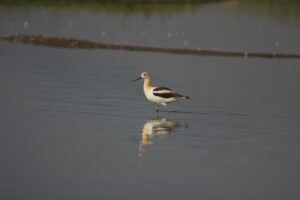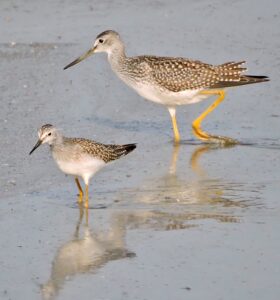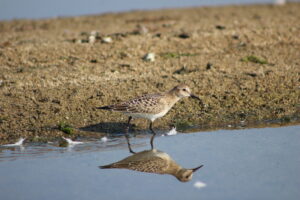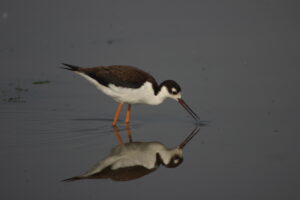By Hilary Turner
Fall is the best time to observe shorebirds in the Greater Yellowstone Ecosystem. A few locally breeding species are present during summer, such as the ubiquitous Spotted Sandpiper, the vociferous Killdeer, and grassland obligate Long-billed Curlew; however, many members of this specialized group were in the high Arctic for the summer and are now headed south toward coastal and neotropical destinations.

American Avocets are among the most visually striking shorebirds and also the easiest to identify, even in non-breeding plumage.
Jackson Lake Dam can be a stellar place to observe shorebirds during July-October, with its sometimes-extensive mudflats. South Park WHMA can also provide good shorebird habitat, depending on water levels, and sand bars and shorelines of the Snake River can also harbor migrants during the fall.
Tringa sandpipers are among the earliest migrants we encounter in the Tetons. Whether failed breeders or northbound migrants that didn’t complete the journey, the large and stately Greater Yellowlegs can appear in the GYE as early as late June. Solitary Sandpipers and Lesser Yellowlegs are smaller members of the genus that arrive slightly later and increase in number throughout the early fall.

Greater and Lesser Yellowlegs by Dan Casey
Check for them wading along sloughs and other small, shallow bodies of water. In non-breeding plumage, the Solitary Sandpiper can look similar to the Spotted Sandpiper. To distinguish them, notice the white spots on the back and wings of the Solitary, as well as its complete white eye ring.
Calidris sandpipers are some of the smallest shorebirds that move through this area. Species like Least, Western, and Semipalmated Sandpipers move through Teton County each fall, utilizing mudflats, sand bars, and floating vegetation mats as habitat while they refuel for their long journeys. Identification is difficult, but paying attention to shape, size, leg color, and foraging strategy is often more helpful than examining plumage characteristics.

Baird’s Sandpiper. Note the golden hue and scalloped back.
The slightly larger Baird’s Sandpiper is truly impressive. Its elongated wings, specialized to take it across continents, are diagnostic in its identification, as well as its golden hue and scalloped back. Some Baird’s Sandpipers, after breeding on Alaska’s North Slope, may travel to the southern tip of South America in a little more than a month.
Dowitchers are long-billed shorebirds that travel from the high arctic to wintering grounds in the southern United States and Mexico. Long-billed Dowitchers are frequently seen during migration in the GYE, but Short-billed Dowitchers can also be detected by a skilled observer.
Juvenile birds are more easily distinguished visually by plumage characteristics than adults, but the best way to identify them is by their different flight calls. Bill length is an unreliable characteristic; while female Long-billed Dowitchers do indeed have longer bills than female Short-billed, there is plenty of overlap in male bill length.
Stilts and Avocets are tall, striking shorebirds and unlike some members of this group, easy to identify.

Black-necked Stilt
The Black-necked Stilt has the longest legs relative to its body size of any bird in Wyoming and the American Avocet has a long, strongly recurved bill that is also unique. Both also have distinct plumage patterns, although the avocet loses its cinnamon head color in the fall. Stilts and avocets are sometimes found in deeper water than other shorebirds, with avocets frequently swimming in water that is too deep for wading.
